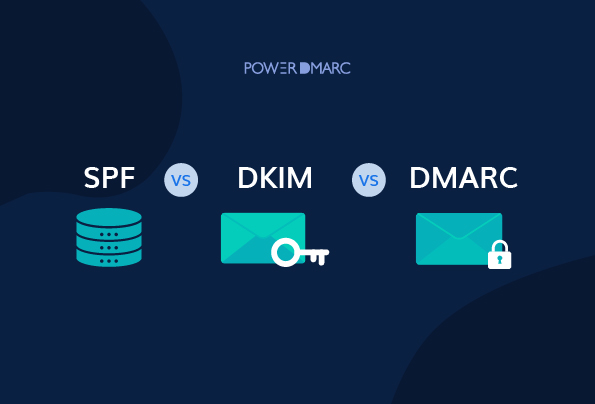There are three main protocols that can be used to verify the authenticity of an email: SPF, DKIM, and DMARC. They all serve to prevent spoofing—the practice of pretending to be someone else’s domain in order to send email through their servers—and they each have their own strengths and weaknesses.
As email has become an essential form of communication for both individuals and businesses, it has also become a primary target for cybercriminals. To protect against email-based attacks such as spam, phishing, and spoofing, email authentication protocols like SPF, DKIM, and DMARC have been developed.
In this blog, we will explore these three email authentication protocols, their differences, and how they work together to provide a robust email security framework.
Key Takeaways
- Implementing SPF, DKIM, and DMARC helps protect against email spoofing and increases email security.
- SPF verifies which mail servers are permitted to send emails on behalf of a domain.
- DKIM adds a digital signature to emails, ensuring they have not been altered during transit.
- DMARC combines SPF and DKIM, allowing domain owners to set policies for handling authentication failures.
- Utilizing these protocols provides greater control over email security and enhances protection against phishing threats.
1. Sender Policy Framework (SPF)
SPF stands for Sender Policy Framework. It is used to verify that a domain is allowed to send emails on behalf of another domain. For example, if you have an email address at [email protected] then you can use SPF to let people know that you sent the email from that domain. If your domain does not have an SPF record, then some servers will reject your emails as spam.
For example, if you’re managing a company’s Google Apps domain and want to allow only Google’s servers to send emails on behalf of your domain, you could add the following SPF record in your DNS settings:
v=spf1 include:_spf.google.com -all
Simplify Security with PowerDMARC!
2. DomainKeys Identified Mail (DKIM)
DKIM stands for DomainKeys Identified Mail and is used to verify the identity of the sender by signing each email with an encrypted hash key. This lets recipients know whether or not the email has been altered in any way since it was sent out by showing them this signature alongside each message in their inboxes. It also helps prevent spam by preventing spammers from sending out fake emails pretending to be from someone else’s domain name.
Here’s how DKIM works:
- Signing the message
The sender’s mail server adds a digital signature to the header of the email message. The signature is created using a private key, which only the sender’s mail server has access to. This signature is unique to the email message and verifies that the sender’s mail server has approved the contents of the email.
- Publishing the public key
The sender’s mail server publishes the public key in the domain’s DNS records. The public key is used to verify the signature in the email message.
- Verifying the signature
When the email message arrives at the receiving mail server, the server retrieves the public key from the domain’s DNS records and uses it to verify the signature in the email header. If the signature is valid, it means that the email has not been tampered with during transit, and the message is considered authentic.
If the signature is invalid, the receiving mail server will mark the email as spam or reject it altogether. This helps prevent phishing attacks, where a cybercriminal impersonates a trusted entity to deceive the recipient into revealing sensitive information or downloading malware.
3. Domain-based Message Authentication Reporting & Conformance (DMARC)
Domain-based Message Authentication, Reporting, and Conformance (DMARC) is an email authentication protocol that combines both SPF and DKIM to provide a more comprehensive email security solution. DMARC allows domain owners to specify policies for how email receivers should handle emails that fail SPF or DKIM checks. DMARC works by adding a DNS record that tells email receivers how to handle emails that fail SPF or DKIM checks.
DMARC also allows organizations to report on messages that fail authentication checks such as SPF or DKIM failures, so they can take action against unauthorized senders who may be spoofing their domains in order to send fraudulent emails under false pretenses.
How can using SPF, DKIM, and DMARC in conjunction with each other improve your domain’s email security?
Implementing SPF, DKIM, and DMARC protocols in conjunction with each other can significantly improve a domain’s email security. SPF verifies the authorized mail servers allowed to send emails on behalf of a domain, while DKIM signs emails with a private key and verifies authenticity at the recipient’s server. DMARC provides a policy framework for email authentication, allowing domain owners to specify how failed authentication should be handled, and provides feedback to help identify and address potential issues.
Together, SPF, DKIM, and DMARC provide a layered approach to email authentication that makes it more difficult for attackers to spoof domains or impersonate senders. They also provide domain owners with greater control over their email security, helping them prevent email-based attacks and ensure that legitimate emails are delivered successfully.
Final Words
With the increase in the frequency and complexity of cyber-attacks, it is essential to take email security seriously. Email authentication protocols such as SPF, DKIM, and DMARC play a crucial role in protecting against email-based threats like spam, phishing, and spoofing. By implementing these protocols, individuals and businesses can safeguard their sensitive information and prevent unauthorized access to their systems.
Email security is not just important for protecting personal and corporate data but is also a vital component of building trust and maintaining relationships with customers and stakeholders. Therefore, it is crucial to take proactive measures to ensure the security and integrity of email communication.
